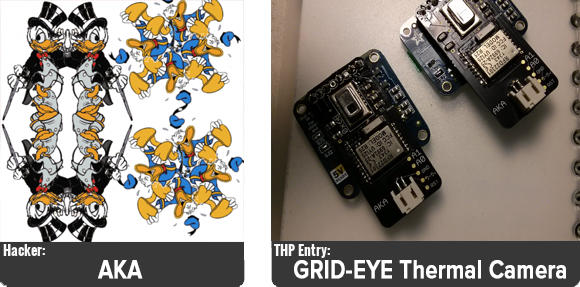Thermal imaging cameras are the new hotness when it comes building DIY tools that are much less expensive than their commercial counterparts. [Mike Harrison] built a very high-resolution version from Flir’s Lepton module, but an IR temperature sensor and a servo can also create a decent image. [AKA] played around with some of these thermal imaging modules, but found them a little hard to interface. Panasonic’s Grid-EYE module, however is reasonably cheap as far as thermal imaging devices go, and can be read over an I2C bus.
[AKA]’s entry for the Hackaday Prize, the GRID-EYE Thermal Camera is one of two Prize entries that survived the great culling and made it into the quarterfinalist round. [AKA] was kind enough to sit down and do a short little interview/bio with us, available below.
![]()
My most accurate answer to this is that my hobby is hobbies: I’m always on the lookout for new communities of ingenious folks who love doing something, no matter how weird. I’ve been deep into lots of different things for as long as I can remember, including gold prospecting, numismatics, recreational mathematics, remote control cars+planes, ardupilot/quadcopters, 3d printers and other CNC platforms, natural radio and numbers stations, hobby electronics, new musical composition and performance interfaces, standup comedy, aqua- and hydroponics, and resilient communities
![]()
I’m a “Maker” at the New York Times R&D Lab.
![]()
![]()
Man, that’s a hard one, but I’d have to settle on the Dremel drill press accessory – it’s so shit that it’s literally better not to have one in your shop, so you don’t fool yourself into thinking it’ll ever do a good job…
![]()
Oh, I use OS X all the time, but I’m trying to learn the linuxes…I started with Angstrom (got a BBB last year) and am moving, with some relief, to Debian
![]()
Most used? A simple but good multimeter. Coolest? My Rigol scope, which cost like $250 IIRC and does more than my previous scope, a Heathkit hand-me-down built by my Dad, could ever dream of. (There’s also that bandwidth-upgrade hack, which I’ve been meaning to try out soon )
![]()
I’m trying hard to increase my comfort with the lower levels of the hardware stack, so I’m using the RFduino (ARM Cortex M0) a lot and enjoying it. So maybe the whole ARM Cortex series? If I had to go lower than that, you can’t beat a good Schmitt trigger…
![]()
Someone once told me that everyone loves their *second* programming language, because it gives you the context to see whether the hard parts are aspects of the programming (framing the actual problem, etc), and which are aspects of the language (syntax, whitespace gotchas, etc). With this in mind, I’m loving Python after a Java/JS-heavy beginning in code. Next up for deep study are Go and C++.
![]()
- Send something into space. This was my 2011 New Year’s resolution that I put off in order to fund my wedding. I obviously don’t regret funding my wedding, but I sure wish I had made good on the resolution as well!
- Fully autonomous project that runs for more than three years
- Some literally miraculous transposition of senses/experience between people
![]()
Honestly, the timing just seemed right: I have long wanted to start a project that would have *some* chance of being used by more people than just me, and I was interested in thermal cameras because they’re still unaffordable for most people. Seemed to me to be a good combination of scope (a really simple, low-component-count project with relatively easy fabrication steps), price, and function.
![]()
I’d love opinions on how to make the project easier to integrate into others’ works (say, to augment a robot’s vision, etc). I made a breakout board for the sensor that should make physical integration easier, but I’d love to hear more about what I can do to make the software side easier…
![]()
I’m blanking on this, unfortunately. Hackaday.io is so full of good work, choosing 50 must have been difficult! Maybe my all-time favorite, though, is the Demolition Man swear punisher (was that even entered into this contest? I’m not sure ). Such an excellent tribute to an excellent movie!
No, that was part of the Sci-fi contest. It also won the grand prize -ed
![]()
![]()
It has been super-fun to be in the contest! Without this external interest I’d probably have done what I usually do, which is get a project to 85% done and then stall forever and eventually get distracted and move on. Even beyond the contest, I really like the UX of the Hackaday.io site – it’s a great way to share work without making claims about its done-ness, suitability for attempting it, etc… nice work!
















That Donald Duck picture on the left side is some new blotter art? Haven’t tried these yet… Where did you get them from?
A couple of clicks take me to rhworkshop.com (and Kickstarter, obviously) for HemaImager. One bullet point among its specs states “Frame rate up to the ITAR-TASS regulations limit of 9 frames per second to any fully Bluetooth- or WiFi-capable device.”
Does anyone happen to know how and why does a respectable, century-old Russian news agency regulate the frame rates of thermal imaging cameras?
ITAR = International Traffic in Arms Regulation
High frame-rate thermal imagers are classified as weapons in much the same way as certain types of encryption used to be.
Case in point, ITAR != ITAR-TASS
Probably afraid they would be used for building heat seeking missile.